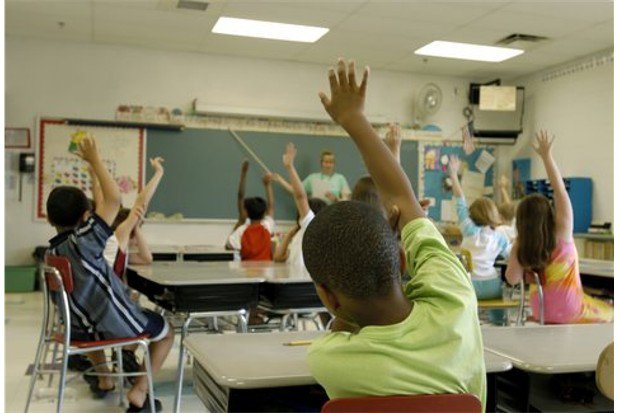Over the last two weeks, I’ve written a series of posts about affirmative action initiated by the fight over SCA5, a bill that would have amended the California constitution to repeal Prop 209 for public education and restore narrow considerations of race to the college admissions process as part of holistic review of qualified applicants. SCA5 was withdrawn after backlash from Asian American voters, but the fight over the morality of race-based affirmative action rages on — particularly in the comments section of my posts, where I’ve been privileged to host several forums to encourage further discussion on this subject.
One significant point of contention is the use of race vs. class in affirmative action. Whereas some SCA5 opponents have lobbed radically non-factual charges against race-based affirmative action, others are more moderate in their counter arguments; they assert that whereas use of race-based information is discriminatory, class-based affirmative action is a reasonable alternative.
And, indeed, the fight over race vs. class-based affirmative action has persisted in liberal circles for years; most recently, support of class-based affirmative action was cited as part of Tanner Colby’s diatribe against race-based affirmative action in Slate.
The focus on class-based affirmative action is appealing to some liberals precisely because it rejects the unseemly conversations of race that can force a conversation on White privilege. Instead, it blames minority underachievement on classism, not racism, and leaves liberals comfortably in support of increased state spending on social services. Tacitly, they argue, if poor minorities can’t pull themselves up by their bootstraps after we address the impacts of their poverty, their failures must then be their fault. In short, arguments in support of class-based affirmative action is viewed as a panacea for social iniquity, with a concurrent, explicit denial of any further impact of institutional racism on underrepresented minority students.
Ironically, the UC system under Prop 209 provides the perfect counter-argument to these charges. California’s public education system, with its late-90’s rejection of race-based admissions, provide the ideal demonstration of the inadequacies of purportedly “colour-blind” admissions policies that engage in class-based affirmative action in the absence of racial consideration.
Or, as Scot Nakagawa points out, post-Prop 209 college admissions in the UC system demonstrate that “in a racially inequitable society, color blind solutions end up reflecting that inequitable context and often even contributes to its perpetuation.”
The logic is actually fairly straightforward. If, as class-based affirmative action supporters argue, the sole cause for academic underachievement in minority communities is based on disparities in income level, then “color-blind” class-based affirmative action should alone be sufficient to adjust for these disparities, resulting in similar admission rates between URM and non-URM applicant groups after holistic review even in the absence of racial consideration.
Yet, as I published last week, the effect of eliminating race-based affirmative action resulted in an immediate drop in admission rates for Black, Chicano and Native American students between 1997 and 1998.
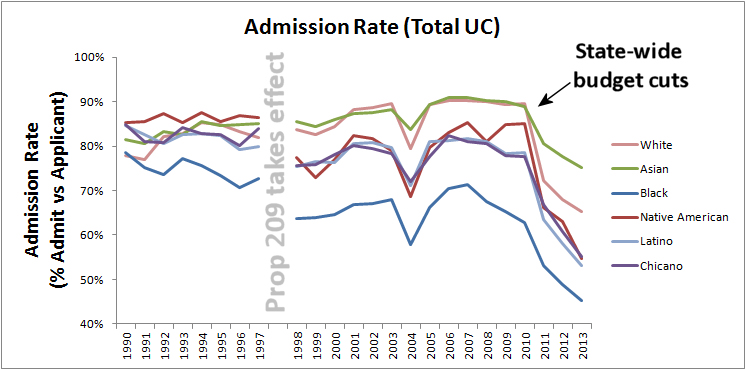
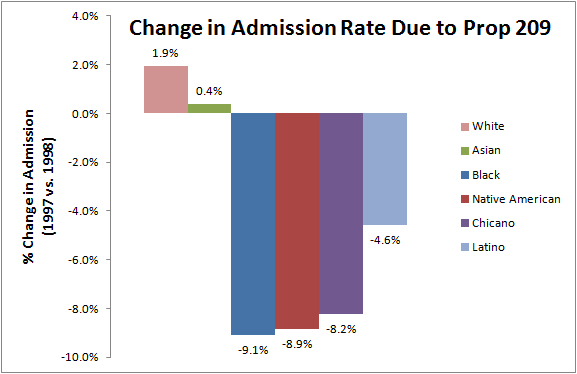
The immediate drop in admission rate for URM students under “colour-blind” class-based affirmative action is striking, and can only be explained by two general possibilities:
- The model of minority pathology: In a model where a significantly higher fraction of URM applicants are deficient or underqualified in some way outside of the effects of class, we would expect URM students to have lower admission rates than Whites or Asians. Perhaps it is a cultural focus on academics, the argument goes, or the increased work ethic of Asian kids; either way, the argument boils down to this: class-based affirmative action approaches an objective meritocracy, and a higher fraction of URM kids just don’t cut it because there’s something inadequate about them. We’ll call this theory the “Triple Package” Model.
- Class-based affirmative action cannot alone adjust for the disparities associated with race and racism: In this model, URM students are culturally and biologically as intellectually capable as their non-URM counterparts, but academically disadvantaged by the (inextricably entangled) effects of both class and race. Thus, class-based affirmative action practiced in the absence of racial consideration is an imperfect adjustment that fails to consider the full (and typically overlapping) impacts of both class and race on a minority kid’s college portfolio. Consequently, the absence of racial consideration impacts URM kids even when disparities in socioeconomic status (SES) are adjusted for.
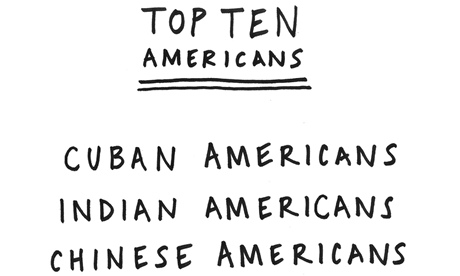
The “Triple Package” Model appears distasteful to consider, yet this is the core assertion — if unadorned by euphemism — of those who would have us focus on the Asian American exceptional work ethic contrasted against the uncommitted nature of their Black peers. To challenge this conclusion, we must ask ourselves if the science reveals any obvious cultural or racial gaps in educational commitment or work ethic between minority and non-minority students, that persist beyond the effects of class.
As it turns out, the myth of minority pathology has been repeatedly demonstrated as just that: a myth. In fact, there is very little evidence to support any sort of racial or cultural rejection of academic pursuits among minority students. In this 1998 study by Ainsworth-Darnell and Downey, investigators found that Black students expressed equal or greater commitment to educational pursuits compared to both White and Asian American peers. In this 2007 article by Charles et al, the gap in parental investment between Black and White families is entirely attributable to disparities in parental income and education; the authors note that according to their data, parental investment would be equal across the races if all families had equal access to equal resources. They write:
With the exception of immigrant Hispanics, gaps in cultural capital [Jenn’s note: extracurricular activities that promote learning; e.g. museum visits] are completely accounted for when background disparities are controlled. Nearly half of the gaps in school parental involvement and household educational items are explained for African-Americans, Native Americans, and Hispanics, and disparities in the likelihood of saving for college early either disappear or actually reverse direction — suggesting that, given equal resources, there is no difference for most groups. Black parents are actually more likely to invest early in the future education of their children relative to white parents.
It is also worth noting that in this same study, the authors conclude that the “high achievement” of children of Asian American families can — in the aggregate — be almost entirely accounted for through the combination of 1) our high median family income, and 2) the opportunities afforded by having parents with significantly higher parental education levels relative to other racial groups; both situations are most predominantly found among first-generation Chinese American and South Asian American immigrant families. And, not coincidentally, these are the two ethnic Asian American groups who are demographically “overrepresented” on UC college campuses.
The story for Asian American students is distinct, and thus worth noting. The Asian advantage in parental expectations, cultural capital, and saving money for college relative to whites is partially or entirely explained by background attributes and, most likely, the higher educational training of Asian parents.
Sadly, as with most studies, the data are not disaggregated to consider Southeast Asian or Pacific Islander families, where parental education is not typically high given low overall secondary education rates. Either way, the point here is that Asian American achievement is not a straightforward result of Asian American cultural or racial exceptionalism; instead it arises as a combination of Asian American discipline and opportunity. Thus, these data would assert the achievement gap between Asian Americans and non-Asian minorities is due primarily to absence of the latter — the resources associated with economic and educational opportunity — and not a cultural absence of the former.
And just this week, the Monthly Labor Review published a research article by Luo and Holden that challenged the notion that African American families are less culturally invested in secondary education for their children: upon controlling for SES, there was no notable difference in either college enrollment or degree of educational expenditures between Black, Latino, Asian or White families.
Given these data (and many more supporting studies), it becomes clear that minority students are not pathologically unqualified students who simply prefer to focus their attention in non-academic pursuits. Given a level playing field, the science tells us that minority students can and will achieve.
Yet, despite their clear racial and cultural commitment to education, minority students are still admitted to the UC system under class-based affirmative action at lower rates than their White and Asian peers. What explains this admissions gap?
Well, quite simply: class-based affirmative action alone does not adjust the playing field; something else is at play — racism. According to our second model, we should be able to identify examples where race and racism impact educational success even when class disparities are neutralized. And, while such situations are far harder to quantify, there are indeed some studies that have pointed to just such impacts of race and racism. I have cited an anecdotal example of a school district in Virginia that constituted of three separate high schools — one predominantly White, one predominantly Black, and one mixed — covering several single- or mixed-race neighbourhoods. Despite being funded by a common pool of state and local taxpayer money, investments in academic and extracurricular classes were widely disparate in this school district: whereas the White school received the lion’s share of funding, the quality of education and extracurricular activities were far more limited at the predominantly Black school. While this is a compelling example of internalized racism at the school board level manifesting in unequal distribution of academic resources, can we find more scientific examples of racial bias impacting K-12 education and achievement?
In his 2005 article, Thomas Dee reviewed the data showing an alarming impact of internalized racial bias in teacher attitudes towards same vs. other-race students, even within a single mixed race classroom. Citing a 1979 study, Dee recounts how White teachers are more likely to view Black students negatively and set lower expectations for them, compared to Black teachers. Later, Dee reviews a study wherein White and Black students were randomly assigned to classrooms with same- or other-race teachers; in this experiment, Black students performed better on tests when paired with same-race teachers. Subsequently, Dee presents his own data, which quantified several examples of teacher bias within the classroom; for example, a White teacher is 1.4 times more likely to view a Black student as disruptive, unruly, or inattentive compared to a White student.
Given these internalized biases, it is perhaps not surprising therefore that as Black students progress through public education, they routinely are shuffled away from academically rigorous tracks or are not challenged to excel at scholastic endeavours. Instead, according to a recent federal report, minority students are far more likely than their White peers to be academically disciplined or punished, to receive these punitive measures routinely and repeatedly, and to be disproportionately subjected to these treatments as early as preschool. From the report summary:
“This critical report shows that racial disparities in school discipline policies are not only well-documented among older students, but actually begin during preschool,” said Attorney General Eric Holder. “Every data point represents a life impacted and a future potentially diverted or derailed. This Administration is moving aggressively to disrupt the school-to-prison pipeline in order to ensure that all of our young people have equal educational opportunities.”
…The data released today reveals particular concern around discipline for our nation’s young men and boys of color, who are disproportionately affected by suspensions and zero-tolerance policies in schools. Suspended students are less likely to graduate on time and more likely to be suspended again. They are also more likely to repeat a grade, drop out, and become involved in the juvenile justice system.
It is important to consider these data alongside the several studies I cited earlier dismantling the myth of Black pathology. This federal report does not suggest that Black students are more disruptive than non-Black peers; rather, consistent with everything presented thus far, they are punished more harshly than other students when they express childhood or adolescent behaviours that would be seen as acceptable or routine among other students.
This racial bias extends, also, to Latino and Pacific Islander students.
The 2011-2012 release shows that access to preschool programs is not a reality for much of the country. In addition, students of color are suspended more often than white students, and black and Latino students are significantly more likely to have teachers with less experience who aren’t paid as much as their colleagues in other schools.
The 2011-12 school year was the first time the CRDC collected data on preschool discipline and the first year that all public schools reported data separately for Native-Hawaiian/Pacific Islanders. As a result, the CRDC shows that racial disparities in discipline begin in the early years of schooling: Native-Hawaiian/Pacific Islander kindergarten students are held back a year at nearly twice the rate of white kindergarten students.
What’s the take-home message? In a nutshell, in addition to class disparities, minority students must pursue their education in a society that views them as unruly, disruptive, and even criminal. Rather than to invest in their education through attention and motivation, schools treat Black, Latino, and Pacific Islander students (and likely other URM) to inordinately low expectations and absurdly high academic discipline rates. These biases manifest in the classroom at virtually every level of K-12 education, and even as early as preschool.
In short, if you’re a 16 year old White or East Asian kid, the world treats you like you belong in school; if you’re a 16 year old Black or Latino kid, the world treats you like you belong in jail.
And, that happens regardless of your family’s income level.
But, in truth, this article has approached the division between race and class as if they could be separated; the reality is that they cannot be. That 81% of Asian American students are enrolled in high schools where they have full access to math and science courses, compared to only 57% of Black students, 67% of Latino students and 63% of students with disabilities may be a consequence of class disparities, but it is a class disparity that is itself informed by the influences of race, racial stereotypes, and racism.
The “Triple Package” argument might largely assert that these racial obstacles can be overcome by a little spit-shine and gumption. It is 2014, after all right?
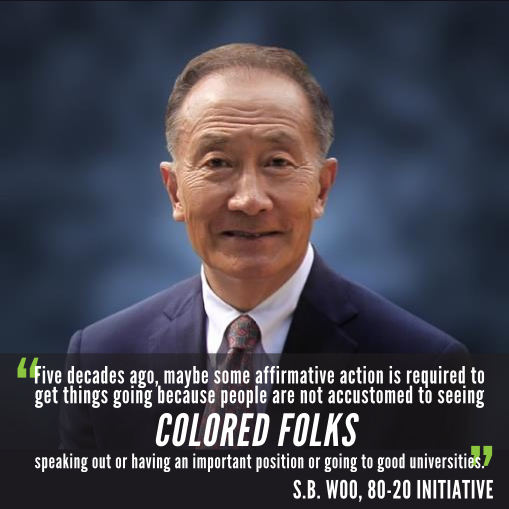
But, that’s right — it’s 2014. It’s only 2014. We are a mere 50 years from Brown v. Board of Education. There are many Black people alive today who have experienced the insidiousness of Jim Crow racism first-hand. We are a mere 150 years — five or six generations at most — from chattel slavery, and the enforced illiteracy of Black slaves involved therein. Is it reasonable to expect African Americans to have circumvented the devastating, dehumanizing impacts of slavery, Emancipation, and Jim Crow segregation on education and achievement? Or, is it, as Ta-Nehisi Coates puts it, a prime example of the expectation of the Black superhuman?
The ultimate goal of race-based affirmative action is not to base college admissions decisions exclusively on race, but it is to incorporate race as one of hundreds of factors considered in holistic review. The purpose of race-based affirmative action is not to subject applicants to racial consideration for the first time in their educational journeys. In short, the idea is not to introduce discrimination based on race; it is to acknowledge that students are already discriminated based on race. It is to acknowledge that students have been tacitly subjected to racial consideration — and consequent bias — long before they made it to the college admissions step, and as far back as when they first entered a classroom; or perhaps, even further back, since the inception of this country. We need race-based affirmative action to empower admissions officers to acknowledge and affirmatively address — narrowly, true, but perhaps for the first time in a minority high school student’s life — the demonstrable, pre-existing negative impact(s) of race and racism that is a fact of their day-to-day lives.
We’ve seen in California what happens when we don’t consider race in college admissions: we invite a system that disproportionately denies access to minority students, and then we invent purported inadequacies to rationalize that denial so that we might sustain a society of widespread second-class citizenry. This is the legacy of how minority scholars — Black, Latino, and yes, even Asian Americans — have been historically shut-out of institutions of higher education for over a century.
Yes, it’s 2014. We deserve better. We deserve a system that values the intellect of Black, Latino, Native American, Southeast Asian, and Pacific Islander students. We deserve a system that opens the door of the Ivory Tower to all.
And, that system fails when it pretends it can be race-blind in a racist world.


